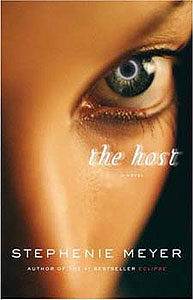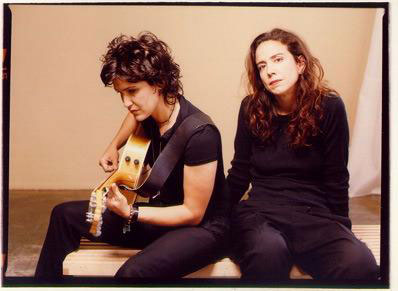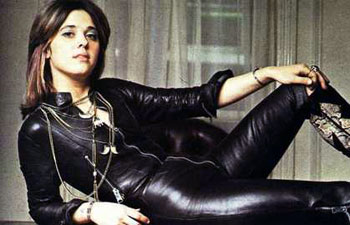“Seductive Subversion: Women In Pop Art”
Published on March 30th, 2011 in: Art, Back Off Man I'm A Feminist, Current Faves, Feminism, Issues |By Chelsea Spear
Exhibit at The Aidekman Center for the Arts
Medford, MA
Free association: When I say the words “Pop Art,” what comes to mind? Screen-prints of Brillo boxes and Campbell’s soup cans, Ben-Day dots on comic-strip women, cartoon collages. And pop artists? Andy Warhol, Roy Lichtenstein, Richard Hamilton, maybe Jasper Johns and Robert Rauschenberg. Like most art movements, Pop Art is considered to be a boys’ club. “Seductive Subversion” seeks to turn this misconception on its head.
(more…)
Beyond Twilight: Stephenie Meyer’s The Host
Published on March 30th, 2011 in: Back Off Man I'm A Feminist, Book Reviews, Books, Feminism, Issues, Movies, Science Fiction |By Lisa Anderson

Stephenie Meyer: Few writers have ever had their work loved and hated so deeply at the same time.
Her Twilight series, consisting of four novels and a novella, has sold over 100 million copies worldwide and been translated into 38 languages, as well as being adapted into a film saga that is set to conclude this year. Meyer has a wide variety of critics, from vampire purists who resent the liberties she has taken with the lore, to feminists who find the relationship between her romantic leads unhealthy. In all the hubbub, though, you hear almost nothing about Meyer’s other brain child: A science fiction novel called The Host which was released in 2008.
(more…)
Portrait of a Reputation: The Woodmans
Published on March 30th, 2011 in: Art, Back Off Man I'm A Feminist, Documentaries, Feminism, Issues |By Chelsea Spear
The early months of 2011 find artist Francesca Woodman in the spotlight. After numerous solo shows throughout the United States and Europe, the photographer will be the subject of a career retrospective at the San Francisco Museum of Modern Art. Her work changes hands for hundreds of dollars. Established photographers like Cindy Sherman and Photoshop illustrators such as Rosie Hardy cite Woodman’s ethereal self-portraits as a key influence.
(more…)
Excellence (Still) Has No Sex: A Tribute To Artist Eva Hesse, 1936 – 1970
Published on March 30th, 2011 in: Art, Back Off Man I'm A Feminist, Feminism, Issues |By Emily Carney
“You won’t believe it. I was told by the doctor that I have the most incredible life he ever heard. Have you got tissues? It’s not a little thing to have a brain tumor at thirty-three.”

Eva Hesse
This was just the beginning of an interview artist Eva Hesse conducted with Cindy Nesmer near the end of her life. The tumult—and ultimate artistic triumph—of Eva Hesse’s inner life was more than apparent in the three-dimensional latex and plastic sculptures which she made near her life’s end.
(more…)
In Defense Of Elizabeth Gilbert
Published on March 30th, 2011 in: Back Off Man I'm A Feminist, Books, Culture Shock, Feminism, Issues, Over the Gadfly's Nest |By Lisa Anderson

Elizabeth Gilbert seems to be a rather divisive literary figure. Her 2006 memoir, Eat, Pray, Love told the story of the year she lived abroad after her first marriage ended. It spent almost two hundred weeks on the New York Times bestseller list, and was praised by Oprah Winfrey. At the same time, it received a lot of criticism in the blogosphere. The gist of the criticism is that many people have problems starker than Gilbert’s, that very few people have the resources to travel for a year as she did, a and that to use other countries as the backdrop for her personal salvation was imperialist at best, racist at worst.
I don’t think that any writer is above criticism, and I’m not trying to silence anyone. I certainly agree that racial and cultural sensitivity are important. However, a lot of what I’ve heard said about Gilbert misses the point of her work, and some critiques are quite sexist. I’d like to point out a few of the things that I’ve heard and explain why I don’t believe they apply.
(more…)
Fetish Art And Feminism
Published on March 30th, 2011 in: Art, Back Off Man I'm A Feminist, Feminism, Issues, Teh Sex |By Kai Shuart
Recently, I finished reading Craig Yoe’s Secret Identity: The Fetish Art of Superman’s Co-Creator Joe Shuster. Yes, it’s true. Even though I’m as much of a feminist as you’re likely to meet, I also love fetish and pinup art. I say this not to claim definitively that pinup or fetish art is feminist; I’m too well aware of the incongruity of these two things to make such a bold claim. Rather, I state my identity as pinup fan and feminist to remind everyone that feminism is not a monolith—it comes in many different varieties. I also state these seemingly contradictory positions to remind everyone that our desires know no political affiliation. We all have fantasies that we can’t explain for the life of us.
(more…)
It’s a Love/Hate Thing: Why Dollhouse‘s Echo Matters
Published on March 30th, 2011 in: Back Off Man I'm A Feminist, Feminism, Issues, Science Fiction, TV |By Catherine Coker

We hate Echo.
Well, many of us do. Because she’s played by Eliza Dushku (who we didn’t have a problem with as Faith, or as Buffy in Faith’s body, come to think of it), or because she is so very much a FOX network construct (iddy-biddy dress and shiny red motorcycle), or because she’s really the misogynist wet dream Joss Whedon never dared to have otherwise (Yeah, I’ve got nothing on that one; anti-Whedonists are a class all their own). When Dollhouse was canceled, the anger wasn’t at television executives it was at Echo.
Why?
(more…)
The Discreet Charm of the Bourgeoisie: Sleep It Off and Doll In The Box by Cristina
Published on March 30th, 2011 in: Back Off Man I'm A Feminist, Feminism, Issues, Music, Music Reviews, Retrovirus, Reviews |By Chelsea Spear
Picture it: the Lower East Side, early 1980s. ZE Records had become the hot indie label, renowned for their tweaking of the nascent disco and no wave genres. The label incubated up-and-coming talent like James Chance and Kid Creole and the Coconuts, and helped spur the Waitresses on to trivia-question status with both of their hits.
While all of these artists have remained in the spotlight, one of the most interesting and peculiar talents got lost in the shuffle: Cristina. This one-named wunderkind of Brechtian disco pastiches, Lieber and Stoller covers and later, an album worthy of comparison with Marianne Faithfull’s Broken English, all but disappeared after her second album, Sleep It Off, barely got released in the States. A few years ago, the reformed ZE reissued Cristina’s discography. How does it stand up, after thirty years?
(more…)
Sometimes It Snows In April: In Praise of Wendy & Lisa
Published on March 30th, 2011 in: Back Off Man I'm A Feminist, Feminism, Issues, LGBTQ, Music |By Paul Casey

Photo from Wendy & Lisa’s MySpace page
When Prince fired Wendy & Lisa in 1986, the most significant writing partnership in that precious little Minnesotan’s career left with them. Not only are Wendy & Lisa credited as co-writers on many classic Prince and the Revolution songs—including “Sometimes It Snows In April,” “Computer Blue,” and “Mountains”—their influence on popular music of the past 30 years is considerable, extending to associated artists, like The Time and Apollonia 6. As well as producing five albums since leaving The Revolution, the duo has written scores for the television show Heroes and currently, Showtime’s Nurse Jackie.
In addition, Wendy & Lisa’s soft, mature approach to their sexuality, especially following The Revolution, mark them as two of the more inspiring musical figures to resonate with the LGBT community.
Suzi Quatro: Like A Lightning Flash
Published on March 30th, 2011 in: Back Off Man I'm A Feminist, Feminism, Issues, LGBTQ, Music, Soundtracks and Scores, TV |By Cait Brennan

It’s hard to imagine how unwelcome women were in the rock music world of the 1960s. While the titans of what we now call “classic rock” were singing about “social justice” and standing up to The Man, the man they were talking about was definitely not the one in the mirror. Most rock stars used and abused women in ways even their fathers and grandfathers would have found offensive, and the notion that women could rock—or should even be allowed to try—was as foreign to the classic rock era as the idea of an openly gay rock star. (Sorry, Jobriath.)
(more…)